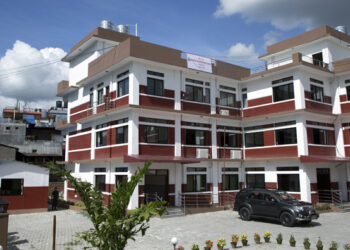The currency swap will provide liquidity support, better debt management, trade facilitation and crisis mitigation to SAARC countries.
This will foster stability and confidence among the SAARC nations leading to strengthened economic relations.
The Reserve Bank of India (RBI), in collaboration with the Government of India, has recently (June27, 2024) introduced an updated Currency Swap Arrangement Framework for SAARC countries, effective from 2024 to 2027.
This initiative is designed to support short-term foreign exchange liquidity needs and address balance of payment crises within the SAARC region.
Originally launched on November 15, 2012, the SAARC Currency Swap Facility aims to provide a financial safety net for these countries.
A new INR Swap Window with a corpus of ₹250 billion is part of the new structure, offering different concessions for swap assistance in Indian Rupee.
Using member state comparative advantages, this benefit promotes higher trade volumes, strengthens regional trade dynamics, and aids in economic efficiencies progress.
Furthermore, the US Dollar/Euro Swap Window, which has a US$ 2 billion total corpus, would continue to be maintained by the RBI.
All SAARC member nations will have access to the facility, provided they accept the bilateral swap agreements.
SAARC (South Asian Association for Regional Cooperation) comprises Afghanistan, Bangladesh, Bhutan, India, Maldives, Nepal, Pakistan, and Sri Lanka.
The economic structures of these countries vary significantly; India is the largest economy in the region with an economic size of USD 3572 billion followed by Bangladesh at USD 446 billion, Pakistan USD 338 billion, Sri Lanka USD 84 billion, Nepal USD 41 billion, Afghanistan USD 14 billion, Maldives USD 7 billion and Bhutan USD 3 billion.

Notes:
1. Data for size of the GDP is compiled from IMF.
2. Size of GDP of Sri Lanka is compiled from the World Bank.
3. Size of GDP of Maldives is for the year 2022, compiled from the World Bank.
4. Data for trade is for FY 2023-24, compiled from Ministry of Commerce and Industry, GOI.
India is the leading SAARC economy, providing support to all the other nations; facilitation in their socio-economic developments and growth of the financial sector.
The revised currency swap to the SAARC nations will provide the following advantages:
Stability and Confidence: During periods of market turbulence, the currency swap facility serves as a financial safety net, reassuring investors and stabilizing local currencies.
The existence of swap agreements helps reduce uncertainty and preserves stability in financial markets when nations experience abrupt currency decline or external shocks.
Because of its stability, investors are more confident, which promotes ongoing investment and economic expansion.
Liquidity Support: Through the swap framework, members of the SAARC will have access to foreign exchange reserves. With this access, central banks are guaranteed to be able to efficiently handle their short-term liquidity requirements, which include funding imports and maintaining exchange rates. The framework lowers the risk of financial disruptions and facilitates smooth economic operations by preventing shortages of money.
Strengthened Economic relations: This system encourages greater financial integration, which strengthens relations between the SAARC countries economically. Increased financial cooperation promotes cooperative development projects, trade, and cross-border investments.
India’s trade with Sri Lanka’s amounted to USD 5.4 billion, key exports to Sri Lanka include petroleum products, textiles, and pharmaceuticals and key imports include ships, boats, aircraft, spacecraft, edible fruits and nuts, beverages and electrical machinery
This integration creates the groundwork for greater regional economic cooperation and shared wealth in addition to bolstering economic resilience.
Trade Facilitation: Smoother trade transactions within the SAARC area are made possible by stable exchange rates, which are made possible by the currency swap mechanism.
For businesses that deal internationally, predictable exchange rates, lower transaction costs and exchange rate risks becomes benign.
Using member state comparative advantages, this benefit promotes higher trade volumes, strengthens regional trade dynamics, and aids in economic efficiencies progress.
Debt Management: The stability of the economy depends on the efficient management of external debt.
The currency swap agreement gives member nations quick access to foreign exchange reserves, giving them a tool to manage their external debt.
By ensuring that nations can satisfy their international financial responsibilities without placing undue strain on their economies, this proactive approach helps prevent possible debt crises.
Crisis Mitigation: The swap facility acts as a quick reaction tool in times of economic crisis, such as unexpected problems with the balance of payments or turbulence in the financial markets.
Through prompt provision of money to nations experiencing financial difficulties, the framework lessens the immediate effects of crises and bolsters attempts to stabilize the economy.
This proactive crisis management capacity strengthens the SAARC region’s overall financial resilience.
India’s trade with SAARC Countries
India’s trade relations with SAARC countries are significant, with particular emphasis on its interactions with Bangladesh, Sri Lanka, Nepal, and Bhutan, where the trade volume exceeds one USD billion.
The overall trade dynamics with these countries underscore India’s role as a pivotal economic player in the region, fostering mutual growth and stability.
Within the SAARC countries, according to the recent data for FY 2023-24, Bangladesh emerges as one of India’s largest trade partners in the SAARC region, with total trade valued at around USD 13 billion.
This strong trade relationship is driven by India’s export of goods such as cotton, machinery, and vehicles, while importing textiles, fish, and leather goods from Bangladesh.
Nepal is another significant trade partner, with total trade amounting to around USD 8 billion.
Despite possible geopolitical and economic obstacles, this proactive step is essential for meeting short-term financial requirements and fostering long-term economic integration.
Major exports to Nepal include petroleum products, vehicles, and machinery, whereas imports from Nepal are textiles, tea, and carpets.
India’s trade with Sri Lanka’s amounted to USD 5.4 billion, key exports to Sri Lanka include petroleum products, textiles, and pharmaceuticals and key imports include ships, boats, aircraft, spacecraft, edible fruits and nuts, beverages and electrical machinery
Bhutan also represents a crucial trade partner, with total trade reaching USD 1.2 billion.
India’s exports primarily consist of electricity, machinery, and consumer goods, while Bhutan’s exports are mainly electricity and minerals.
India’s trade with other SAARC countries including Afghanistan, Bhutan Maldives and Pakistan is around USD 1 billion.
India’s significant trade partnerships with major SAARC countries including Bangladesh, Sri Lanka, Nepal, and Bhutan are attributed to historical ties, geographic proximity, and complementary economic structures.
These countries rely on India for essential imports, while India benefits from their exports of textiles, minerals, and agricultural products.
In conclusion, the Reserve Bank of India’s updated Currency Swap Framework for SAARC nations is a move meant to improve economic cooperation and financial stability in the SAARC region.
With bilateral swap agreements, this framework seeks to minimize balance of payment situations and promote stronger economic relations among the SAARC nations while offering short-term cash support.
India’s commitment to regional economic resilience is demonstrated by the creation of an INR Swap Window in addition to ongoing support in USD and EUR.
Despite possible geopolitical and economic obstacles, this proactive step is essential for meeting short-term financial requirements and fostering long-term economic integration.
In a nutshell, the framework is a major step towards a more stable and cooperative economic environment in South Asia.









Comment